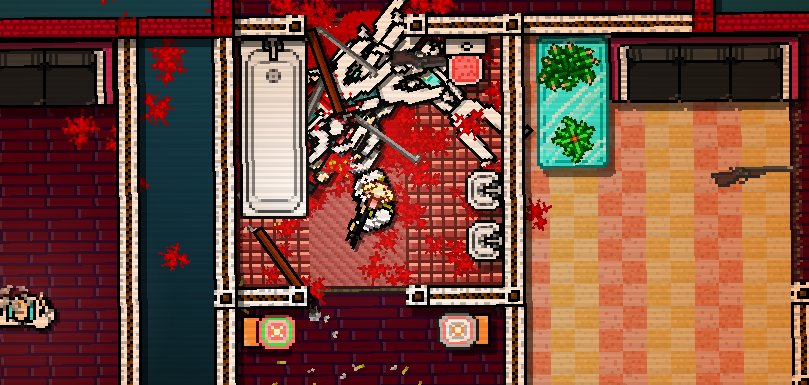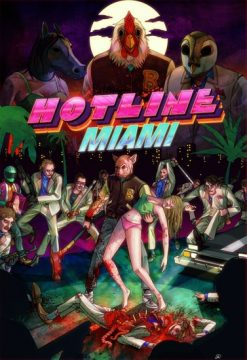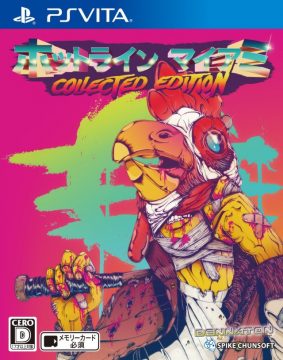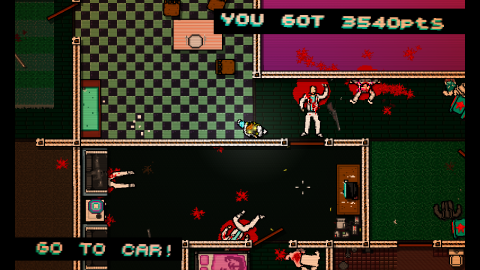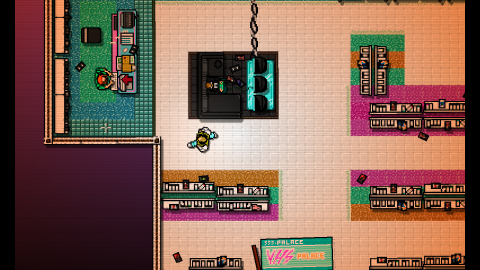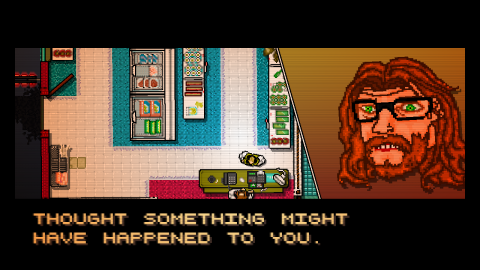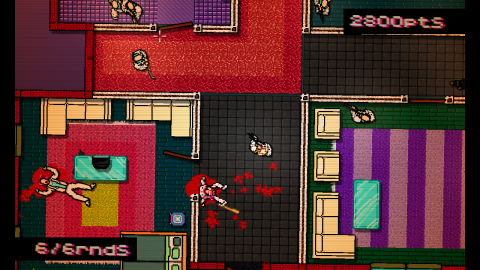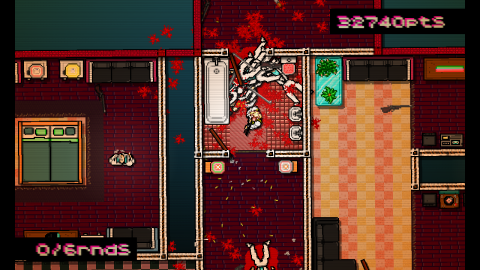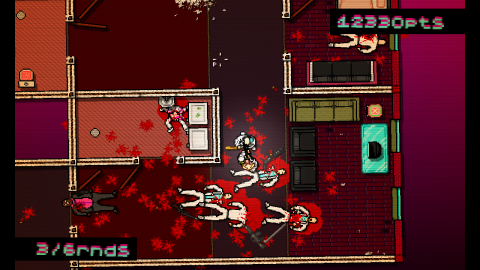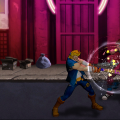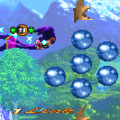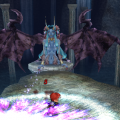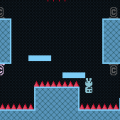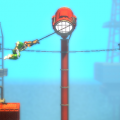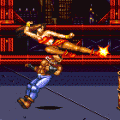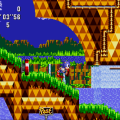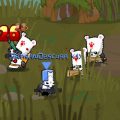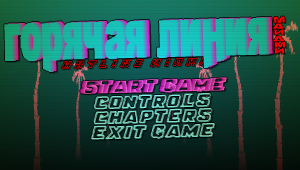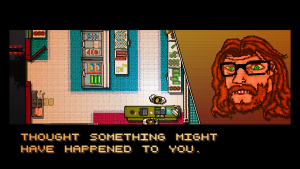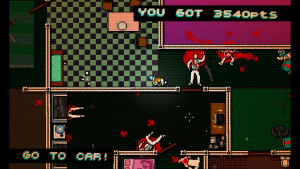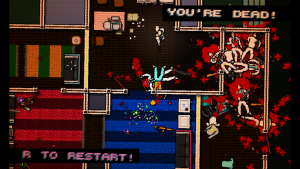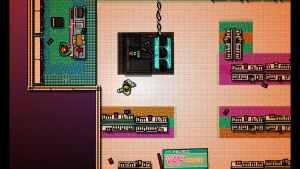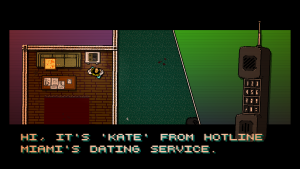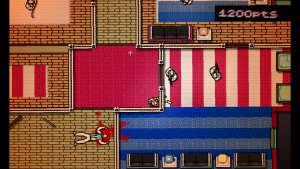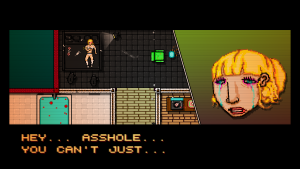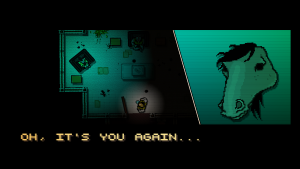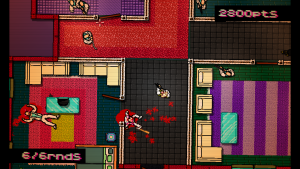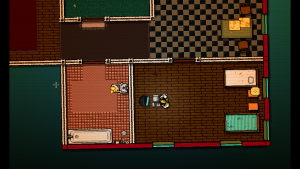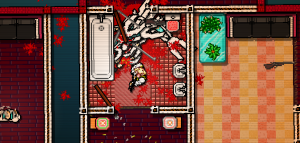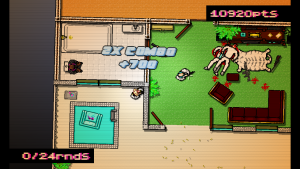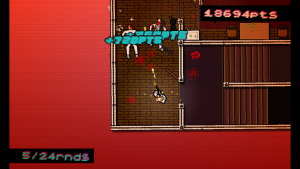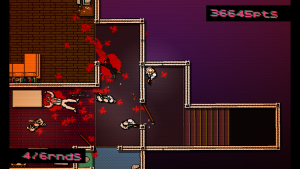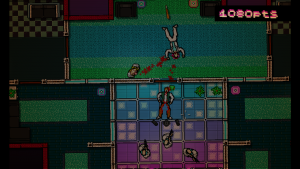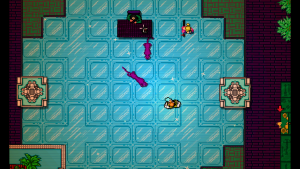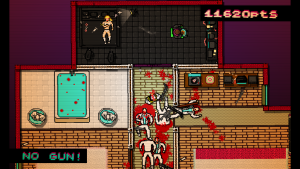- Hotline Miami
- Hotline Miami 2: Wrong Number
Hotline Miami presents itself with bizarre and slightly disturbing official art, uses a whimsical rainbow of colors to paint a gritty crimescape, and ultimately taps into that most primal element of violence. It’s the brainchild of famed indie programmer Jonatan Söderström and graphic artist Dennis Wedin. Söderström, better known as “cactus,” is acknowledged for having put out a large stable of games (most of which are radically FUBAR) with relatively short development time. Some of his better known projects include the nightmare third-person puzzle game Mondo Medicals and its sequel Mondo Agency, and the minimalist neon shoot-em-up Clean Asia! He has teamed up with Wedin before on the fantastically named Keyboard Drumset Fucking Werewolf, and Hotline Miami is the first title to be released under their newly-formed label, Dennaton Games.
Taking place in 1989 Miami, the plot is actually slightly more sane for a typical cactus romp, though that’s not saying much considering the very first thing to do is learn how to kill from a hobo, converse with three anonymous agents wearing highly unnerving animal masks, then murder the hobo from earlier in cold blood. The idea is that you are an assassin-for-hire who wears a varsity letterman jacket (with “B” emblazoned on it in the official artwork) and takes anonymous phonecalls from clients looking to eliminate unscrupulous criminals which turn out to be the Russian Mafia (hinted at by the title screen’s appearance in Cyrillic).
After each mission, you head by the local pizza joint or VHS rental store and talk with the same friendly bearded glasses dude who gives you something for free and bids you a nice night. You then wake up another day to get your next mission, and this is the basic format for much of the game. As you may expect, it doesn’t stay like this forever, and things become increasingly disturbing and improbable until it takes a drastic turn for the worse. The plot itself is actually quite enjoyable and, at times, makes you feel guilty for being a stone-cold killer. Granted, there are quite a few questions that aren’t explained by the game’s end, but the mystery can be said to enhance the game’s dark atmosphere. It also takes a fair deal of inspiration from the recent neo-noir hit movie Drive, to the point that the film’s director, Nicolas Winding Refn, is thanked in the credits.
The plot is as minimalist as the easy-to-understand gameplay. Your directive in every level is simple: Kill everyone! Some missions give you an additional objective like taking a briefcase or rescuing a prostitute, but these are always asides to the main monkey business of slaying your foes, which primarily consist of bald mobsters in white suits. While you start out each mission unarmed (unless you wear one of three masks that gives you a starting weapon), all you need is to knock down one thug or find a stray weapon to really get started.
The controls are simple: WASD movement by default, targeting with the mouse, left mouse button attacks, right mouse button picks up items or throws them, middle mouse locks onto targets, and spacebar to perform “executions” on not-quite-dead-yet enemies. When unarmed, you toss punches that instantly knock down baddies and cause them to drop their weapon, but that never quite kills them; you have to walk over their bodies and press space, followed by hitting the attack button several times (or just once if they’re against a wall) to end them. You can even press space for a quick kill if you catch them unaware while standing. Furthermore, you can K.O. enemies simply by walking through doors and slamming the doors into them when they get close.
The arsenal at your disposal primarily consists of three weapon varieties: Melee weapons (both blunt and edged), firearms, and thrown weapons, most of which are improvised. Enemies themselves frequently carry baseball bats, knives, and lead pipes for melee, and assault rifles and two types of shotguns for firearms with the occasional pistol or submachine gun. This is mostly what you’ll find strewn about the floor as well, but gaining points in missions unlocks the use of more exotic weapons such as katanas, large fire axes, revolvers, and even shuriken. Admittedly, the weapons you unlock don’t show up as much, but you should be able to do more than enough damage with the basics.
Most melee weapons have decent range but you have to swing them at the right time, or else you miss and invite the enemy to return the favor. For as short as the knife’s range is, it does swing faster than most other melee types. Guns differ a fair deal amongst each other, like the rifle offering speed and a decent clip but not necessarily fatal shots, weighed against the more powerful shotgun which WILL kill whatever it hits, though it fires slower and only carries six shells. One-handed guns even allow you to take knocked-down enemies as hostages and use them as meat shields, though this tactic is often pretty risky. All weapons can be thrown whether or not they’re specifically designated for it, though most thrown weapons only knock down enemies without killing them. Still, when you’ve got an empty gun in your hand, it’s better than nothing.
Before each mission, you are prompted to choose from a potential pool of twenty-six creepy animal masks like the ones worn by those three mystery men. The masks aren’t just an aesthetically disturbing motif, but they also affect your style of play by bestowing an extra ability to augment your strength, speed, perception, or what have you. The mask you start out with, a chicken-head named “Richard,” has no special abilities and will probably be forgotten once you equip something that actually offers you an advantage. However, you’ll have to deal with Richard for the very first stage, as the other masks need to be unlocked. Most of them are achieved by earning high scores in most of the levels, the target scores aren’t too bad to beat.
Other masks are hidden within stages and need to be found, but the very first mask you can unlock, “Rasmus” the Owl, makes it easier to find secrets by giving them a distinct glow. You’ll soon unlock even more for your latex zoo; take “Tony” the Tiger (yes, they went there), which gives you insta-kill fists and quicker spacebar executions, or “Don Juan” the horse which automatically kills enemies every time you slam a door onto them instead of merely knocking them down. Other masks have you start out with a free weapon, increase the amount of guns or melee weapons that can be found, allow you to survive a stray bullet or two, and other neat abilities which accommodate a wide range of play styles. Whether you prefer close combat or distance shooting and are bold or conservative, there’s definitely a mask for you. There are a few who merely offer cosmetic alterations and even a couple which handicap you, but you can definitely win each stage regardless of what mask you pick, so you don’t need to plan meticulously and go with the best bonus for the job.
Regardless of what mask you pick, the Mafia men you fight against will be aggressive and vicious. Dudes with melee weapons will often rush you the instant they cross into your line of sight and fatally bash you the instant they get close enough. Gun-toting thugs are even worse and will be able to blow your brains out from off-screen unless you’re looking ahead with shift. They’re as fragile as you are, but they are many and you are but one. It may be in your best interest to stay quiet with melee and silenced weapons, but there may be advantages to attracting enemy attention with gunfire and having them rush in as you pick them off.
The riskier your play style, the higher your score and the better chance you have of earning the stage’s mask, but do not underestimate your foes. While 90% of your enemies are the typical mob henchmen, there are a few other types of jeopardies to keep things interesting, including boss fights at the end of each act. When you clear out most of the enemies in the third chapter, a large black man rushes you and attempts to knock your lights out with a single punch. He cannot be killed by melee attacks and takes three shotgun blasts before you can finish him. From that point on, big enemies which look like the first boss roam about and can only be taken out by gunfire, even though they take less damage than the original. Later chapters also give you dogs to deal with, which tend to be more aggressive than humans and cannot be touched with your bare hands. There are also some particularly dirty tricks that get thrown at you here and there; without spoiling too much, be ready to make a REALLY quick exit when you beat chapter nine.
So Hotline Miami is a harsh game. It’s hard to accurately measure its difficulty, but it’s likely to be very daunting for newcomers. To your advantage, the levels (of which there are twenty-one) are all short, you get a checkpoint for each room you clear of thugs, and when you die, a simple tap of “R” quickly places you to the beginning of the room you’re on. The tradeoff to all this is the ruthless and headstrong artificial intelligence, combined with the fact that you can only take one hit. It seems tough enough in the first few stages, but it’s definitely nothing that can’t be beaten with a little patience… except by the third act, you will definitely need MUCH more than just a little patience. There’s a definite difficulty curve that steeps pretty highly in the latter half, and it’s quite clear that the game wants you to die. A LOT. One of the pre-stage message hints even outright tells you “don’t be afraid of dying,” and you will definitely be doing so a lot. That leads to perhaps the biggest fault with how the game plays, as it feels like you can’t help but lose at certain points until you get lucky enough to not have your head blown off a millisecond before you pull the trigger.
If you’ve ever heard game reviews use the condescending remark of “if you die, it’s your own fault” to advocate how smooth a game’s control feels, that’s definitely not the case in HM. It can be hard to accurately throw or shoot enemies unless you use the lock-on, and even then, it can be really difficult to target your cursor on an enemy while on the move. The gameplay does feel sloppier than it should at points and you may be shouting several obscenities when the chapters get up to double digits, but the quick reload after death prevents it from ever feeling TOO punishing. For as imperfect as the mechanics are, the simplicity and intensity of the fighting is just too fun to dislike. Furthermore, this game isn’t all about how it plays, but how it looks and sounds is also a big part of its design.
Hotline Miami’s graphics are among some of the most unique in recent design history, as it has a distinct simple and low-tech feel, but not quite like a homebrew NES game. Rendered entirely in 2D, there is quite a lot of detail put into the interiors of buildings, making them seem like dirty bungalows or upscale penthouses. The sprites themselves exhibit surprisingly fluid animation, except when they instantly collapse from abrupt deaths which emphasizes how quickly fatalities happen in this game. There are two significant factors that set HM apart from any pixel game, the first of which is the constantly psychedelic background that makes the player feel as if they are under some sort of foul influence. The area outside of buildings is always blanketed by some blank haze that randomly shifts between deep red, violet, blue-green and all sorts of other colors. The buildings themselves slightly tip left and right as you walk around, and disembodied character heads tilt back and forth whenever anybody speaks.
If this sounds slightly sickening, then it’s relevant to mention that the second unique point of the aesthetics is the gore. Oh god, so much exquisite gore. Whether it’s your body or the bodies of countless mobsters you create, the results are shockingly realistic despite the retro graphics. Blunt tools can cause broken necks, pools of blood leaking out of heads, or even smashed skulls with all the brainy bits flying out. Bladed weapons equals ripped bodies with exposed entrails, decapitated heads, or entirely bisected torsos. Guns lead to lots of bullet holes and missing limbs or heads thanks to concentrated shotgun fire. Even unarmed, your executions are merciless as you repeatedly punch or slam downed mobsters’ heads on the floor until they’re reduced to bloody chunks. If they slump against a wall, you can quickly kill them with a single head-crushing kick. This game is violent, dirty, filthy, and it just may make you feel a bit sick to cause so much wanton murder, which is likely what the creators were going for. The combination of druggish perspective and visceral death may be a put-off to some, but it’s also hard to argue the outstanding efficacy of the visual tone, as nothing else looks quite like it and never will resemble it: unless cactus has a potential sequel in mind.
To complement the illustrious graphics is one of the best soundtracks in recent memory. The OST is utterly phenomenal and almost impossible to dislike even if you’re not big on the game itself for whatever reason. Dennaton got no less than nine indie musicians to work on the game, including M.O.O.N., El Huervo, Scattle, and Jasper Byrne, who is also the creator of the horror game Lone Survivor. The music in most cases sounds like what would happen if you fuse the gentle electronic rhythms of Tangerine Dream with the dark gothic energy of Sisters of Mercy, though that description doesn’t even really do it justice. From the spacey pop feel of “Crystals” to the almost cinematic dirge of “Knock-Knock,” the soundtrack keeps you going until you kill absolutely everyone in a stage and the unsettling ambience of “Crush” sets in to unnerve you as you reflect on what you’ve just done. It’s really hard to pick any one track out of the rest that really stands out, and it’s easily worth a purchase on its own, especially as an introduction to synthwave.
Hotline Miami is indeed a game evocative of how pop culture remembers late-eighties Miami life: Hard, fast, psychedelic, rough, and exhilarating all the same. It’s an incredibly simple premise when you get right down to it, but the game is arguably stronger for remaining consistent. The extreme vigor of running through each stage never really makes the basic formula ever feel old, yet new challenges and twists are thrown at you in just enough capacity that you always want to play on so you can see what else the twisted mind of cactus has in store for you. Granted, the game does rely a good deal on its aesthetics to give it a unique sense of identity and can be argued to emphasize its style more than its substance, but strip away the funky appearance and synthesizers and you’re still left with a fun and briskly paced(if slightly unfair) overhead shooter. It’s sort of like the classic PlayStation killfest Loaded with trace stealth elements a la Metal Gear, which when fused with its periodic setting and copious quantities of blood and carnage which even puts Grand Theft Auto: Vice City to shame, adds up to one of the best independent games of the modern day. It’s a trippy, fierce, and gruesome experience that no hardcore gamer (and those who are not squeamish) should refuse.
